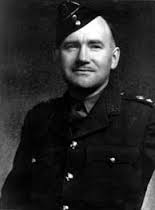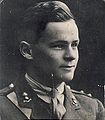St. Louis, Archibald Romuald
| Archibald Romuald St. Louis | |
|---|---|
| 21 April 1897 – 12 February 1954 | |
 | |
| Nickname | Archie |
| Place of birth | Moosemin Saskatchewan |
| Place of death | Ottawa Ontario |
| Place of burial | Beechwood Cemetery, Ottawa |
| Allegiance | Canada |
| Service/branch | Canadian Army |
| Rank | Colonel |
| Awards | OBE |
Early Life
Archibald St. Louis was born in Moosemin Saskatchewan to Francois Gadiou-Saint Louis (1859-1909) and Sarah Jane Stutt (1868-1947). He had two brothers, Wellington (1892-1894) and Jean Napoleon (1897) both with the surname "Gadiou-Saint Louis" who died young and two sisters. Archie's father died in 1909 and his mother later moved the family to Winnipeg where Archie completed high school and 9 months of university before he enrolled for military service with the Canadian Expeditionary Force.
Great War Service
Archie St. Louis enrolled in the Canadian Expeditionary Force (CEF) as a Private at Winnipeg in May 1917. He served in France as a member of the 16th Battalion (Canadian Scottish), CEF. After a month he was transferred to the 8th Battalion (90th Winnipeg Rifles), CEF joining it in time for the last engagement of Second Battle of Ypres – the Second Attack on Bellewaarde on 25 September 1915. Archie remained with the 8th for 12 months before he was sent to the Canadian Engineers for employment. He was attached to the 3rd Canadian Divisional Signal Company on 1 May 1916.
After three months he was transferred to the Canadian Corps HQ Signal Company where according to his File he alternated between employment at the HQ itself or in the Wireless Section. On 11 August 1916 Archie was appointed Acting 2nd Corporal and was confirmed in rank on 1 November. On 5 March 1918 Archie joined 4th Canadian Divisional Signal Company, CE and, on 18 March was promoted Sergeant. Archie’s time at division was short-lived, for on 23 April he fell from a bicycle and injured his abdomen. This turned out to be serious and resulted in an appendectomy being carried out by the surgeons at No. 7 Casualty Clearing Station on 23 May 1918, followed by medical evacuation to England on 31 May.
He recovered at No. 4 Military Hospital (Reading War Hospital) for 61 days before being transferred to the Military Convalescent Hospital, Woodcock Rd, Epsom. Once fit, Sgt St. Louis was transferred to the 1st Canadian Engineer Reserve Battalion and on 1 January 1919 he was made a Temporary Lieutenant in the Canadian Engineers.
On 7 January 1919 Archie was transferred to the "Cdn Engineers Fmn (?) Canada", Seaford, and shown on Indefinite Leave pending his return to Canada with a furlough address of 47 Kerr St, Pollokshields, Glasgow. He returned to Winnipeg in August of 1919 on the Corsican out of Liverpool, arriving in Quebec on 18 Aug 1919. Archie was demobilized on 22 August 1919 from the Canadian Expeditionary Force.
Service Between the Wars
In 1920, after only a year as a civilian, Archie joined the permanent force as a Lieutenant in the Royal Canadian Engineers. He was initially posted to Quebec where his first son, “Paddy”, was born in February of 1920. He was later posted to Camp Borden where, in 1922, he served as Chief Instructor at the Third Royal School of Signalling. Despite being assigned Singalling duties, for a time Archie remained as a member of the Royal Canadian Engineers as there were no vacancies in the establishment of the Royal Canadian Corps of Signals. This was rectified in effective 1 March 1924 when he was transferred to the Corps.[2]
Capt St. Louis stayed on in Borden and served as the Commanding Officer for the periods of 1 November 1922 to 22 July 1923, 2 September 1923 to 31 May 1924 and again from 6 October 1925 to 12 March 1926. The later period being when Major Earnshaw, who was appointed Commanding Officer 1 June 1924 was away on course.[3] In 1926 he was appointed District Signalling Officer of Militia District 10 and he moved with his family to Winnipeg where he spent the next three years establishing radio communication stations in Northern Manitoba.
In the Spring of 1929 he resigned his commission to pursue civilian employment.
Second World War Service
Upon his return to Canada, Archie enlisted in the Royal Canadian Corps of Signals once again. Now Captain St. Louis, he was posted to Work Point Barracks, Esquimalt British Columbia to the Headquarters of Militia District 11. The peacetime District Headquarters wasn't well suited to the expanded role of the defence of the West Coast and so Pacific Command was created. Pacific Command's area of responsibility spanned Britsh Columbia and Alberta as well as the Yukon and Northwest Territories and was charged with the defence of three sea-ports of strategic value, Victoria/Esquimalt, Vancouver and Prince Rupert. In April 1941 Captain St. Louis is noted as Staff Officer Signals, Pacific Command. By October, he was promoted Major and, by December, made the Chief Signal Officer, Pacific Command and promoted to Colonel.
The History of the Canadian Signal Corps describes his achievements:
- "To the indefatigable Chief Signal Officer (CSO) of Pacific Command, the late Col A.R. St Louis, must go credit for initiating a gigantic communications enterprise in British Columbia. His plan was to link by land-line all communications centres in the Command. It was a prodigious undertaking – indeed the greatest of its kind in North America – requiring RCAF and civilian participation and utilizing, among other items, over a thousand miles of 8-pair copper wire.
- "In January 1941 a survey of communications facilities throughout Pacific Command was begun. A year later a complete plan for a combined services communication system was submitted to National Defence HQ by the CSO, and in May 1942 the Chiefs of Staff approved the plan and the necessary funds were provided. Actual construction was the responsibility of Col St Louis and an RCAF liaison officer was posted to Vancouver to co-ordinate the work of all departments and groups involved, with administrative and financial control vested in the Deputy Minister of National Defence.
- "The plan embraced the entire coastal region of the Command, utilizing a north-south route through the Cariboo parallel to the existing facilities of the Government Telegraph service, and involving also the British Columbia Telephone Company and the Canadian National and Canadian Pacific Telegraphs. The work was divided into two main areas – on Vancouver Island from Victoria through Alberni to Campbell River and from Alberni to Cape Scott, and on the mainland with lines from Vancouver to Bella Coola via Ashcroft and 150 Mile House and from Quesnel through Prince George to Prince Rupert.
- "On the Island No. 11 Area Signal Company, No. 11 District Depot, the RCAF, RCE, 18th Infantry Brigade, Forestry Corps and even linemen from Atlantic Command Signals were employed, while the work on the mainland was done by Nos. 9, 10 and 11 Area Signal Companies, No. 11 District Depot, 3rd Battalion Edmonton Fusiliers, Divisional Signals, RCAF and RCASC personnel. At the peak of the project over one thousand enlisted men were employed, and about an equal number of civilians working for commercial companies. About 100 trucks, 50 horses, and some 30 boats of various types were busy on the job. The mountainous terrain encountered in most areas not only presented stupendous construction problems but made the movement of supplies and equipment equally difficult. This vital project requiring almost 2,000 tons of copper wire strung on 72,000 poles provided 60,000 circuit miles of communications which were later supplemented by 585 miles of F/M radiophone circuits. From any and every viewpoint the Pacific Communications project was a gigantic undertaking carried to completion in the space of only two years at a cost of eleven million (1940) dollars."[4]
For his service during the Second World War, Colonel St. Louis was appointmented to the Most Excellent Order of the British Empire (OBE).[5] His service complete at the end of the war, he again returned to civilian life being struck off strength June 10, 1946.
Civilian Employment
In 1929, with the benefit of his experience with telecommunications on the ground and in the air (from his work with the RCAF’s air mapping efforts), he took up civilian employment with the American Aviation Company to provide similar services to the newly formed China National Aviation Corporation and moved his family to Shanghai, China. His official title was "Ground Communication Radio Engineer".
When his contract with CNAC was up Archie and a couple of his like-minded friends formed the Asia Electric Company which became a huge success in a very short time; they built a factory and trained workers to manufacture household electrical appliances including fridges, stoves and smaller items such as toasters and fans.
The year 1939 signaled the end of his days in China with the war in Europe clearly on the horizon and Shanghai, China surrounded by the Japanese army. Archie quietly made preparations to leave in the spring of 1940 and the family sailed on the Nagasaki Maru an NKY Lines ship from Kobe, Japan to Vancouver.
After the Second World War Archie joined the Federal Electric Company in early 1947 and moved his family from Vancouver to Montreal that spring. He personally took up residence in Ottawa as the company’s representative later that same year and it was still working in that capacity when he passed away.
Personal Life
While hospitalized at Reading in 1918, he met his future wife who was a member of the Volunteer Aid Detachment. He and Margaret Hodgson of Haswell, Durham, England married on February 12, 1919. Together they had seven sons: Louis (Paddy) Romuald (b. Winnipeg 1920), Bruce Anderson (b. 1922 Quebec City), Peter Borden (b. Camp Borden 1923), Archie Leopold (b. Camp Borden 1927), Paul (b. 1930), John, and Charles (Chappy).
Archie passed away from a heart attack on February 12, 1954 at the young age of 57 and is buried in Beechwood Cemetery, Ottawa. Archie’s wife Margaret died in Ottawa in 1985.
Related Pages
Related Items
References
- ↑ Research for this page contributed by LCol (Ret'd) Mac Savage
- ↑ The Signal Depot, Royal Canadian Corps of Signals. Part II Order No. 137, 9 June 1924.
- ↑ Semaphore to Satellite page 441.
- ↑ History of the Royal Canadian Corps of Signals 1903-1961 page 232.
- ↑ The London Gazette, Supplement 36545. 2 June, 1944. Page 2654.





